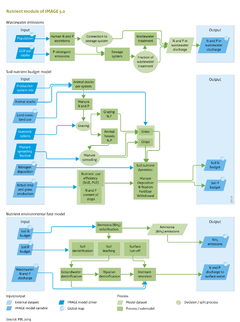Nutrients: Difference between revisions
Jump to navigation
Jump to search
No edit summary |
LexBouwman (talk | contribs) No edit summary |
||
| Line 1: | Line 1: | ||
{{ComponentTemplate2 | {{ComponentTemplate2 | ||
|Status=On hold | |Status=On hold | ||
|IMAGEComponent=Scenario drivers; | |Application=Global Environmental Outlook - GEO3; Global Environmental Outlook - GEO4; Millennium Ecosystem Assessment; OECD Environmental Outlook to 2030 (2008); OECD Environmental Outlook to 2050 (2012); Resource Efficiency; Rethinking Biodiversity Strategies (2010); Roads from Rio+20 (2012); SSP project; The Protein Puzzle (2011); | ||
|KeyReference=Bouwman et al., 2013; Bouwman et al., 2009; Van Drecht et al., 2009; | |IMAGEComponent=Scenario drivers; Agricultural economy and forestry; Agricultural systems; Agriculture and land use; Aquatic biodiversity; Emissions; Land cover and use; Livestock; | ||
|KeyReference=Bouwman et al., 2013; Bouwman et al., 2009; Van Drecht et al., 2009; | |||
|Reference=Bouwman et al., 2011; Galloway et al., 2004; Zhang et al., 2010; Diaz and Rosenberg, 2008; UNEP, 2002; Rabalais, 2002; | |Reference=Bouwman et al., 2011; Galloway et al., 2004; Zhang et al., 2010; Diaz and Rosenberg, 2008; UNEP, 2002; Rabalais, 2002; | ||
|InputVar=Population per Region; Urbanisation; GDP per capita; Land cover; Crop production; Fertilizer use efficiency; Animal stock; Livestock ration; Manure spreading fraction; Nitrogen deposition; Ammonia (NH3) loss; | |InputVar=Population per Region; Urbanisation; GDP per capita; Land cover; Crop production; Fertilizer use efficiency; Animal stock; Livestock ration; Manure spreading fraction; Nitrogen deposition; Ammonia (NH3) loss; | ||
Revision as of 16:19, 6 January 2014
| Component is implemented in: |
| Components: |
| Related IMAGE components |
| Projects/Applications |
| Key publications |
| References |
Key policy issues
- How will the increasing use of fertilisers affect terrestrial and marine ecosystems, with possible consequences for human health?
- To what extent can the negative impacts be reduced by more efficient nutrient management and wastewater treatment, while retaining the positive effects on food production and land productivity?
